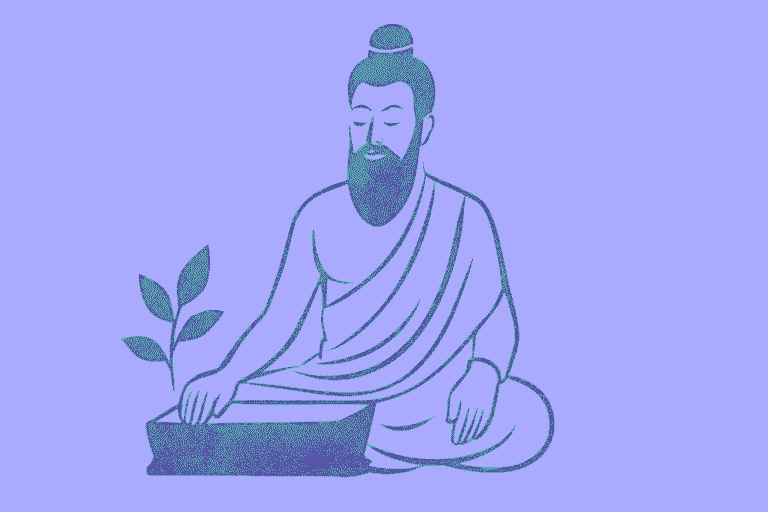contact@cayeit.com
Jamu, a traditional herbal medicine deeply rooted in Indonesian culture, has been an integral part of the archipelago’s healing practices for centuries. This ancient elixir, passed down through generations, represents more than just a medicinal concoction; it embodies the wisdom, traditions, and holistic approach to health that Indonesians have cultivated over time.
The origins of Jamu can be traced back to the ancient Javanese kingdoms, where it was initially developed in royal palaces. Historical records suggest that as early as the 8th century, Jamu was being used to maintain the health and beauty of royal family members. The knowledge and recipes were carefully guarded secrets, passed down from mother to daughter within the palace walls.
As time progressed, the practice of preparing and consuming Jamu spread beyond the confines of royalty, becoming an integral part of Indonesian daily life. The art of creating Jamu became a revered skill, with practitioners known as Jamu Gendong (literally meaning carrying Jamu) roaming villages and cities, selling freshly prepared concoctions to eager customers.
The cultural significance of Jamu extends beyond its medicinal properties. It represents a holistic approach to health and well-being, emphasizing the importance of balance between mind, body, and spirit. This philosophy aligns closely with traditional Indonesian beliefs about the interconnectedness of all aspects of life.
In modern Indonesia, Jamu continues to play a vital role in society. Despite the influx of Western medicine and pharmaceutical products, many Indonesians still turn to Jamu as their first line of defense against various ailments. The practice has even gained recognition from the Indonesian government, which has established regulations and standards for Jamu production to ensure quality and safety.
The enduring popularity of Jamu speaks volumes about its effectiveness and the deep-rooted trust Indonesians place in their traditional healing methods. As the world increasingly turns to natural and holistic approaches to health, Jamu stands as a testament to the enduring power of ancient wisdom in the modern age.
The Diverse Ingredients and Their Medicinal Properties
Jamu’s effectiveness lies in its diverse array of natural ingredients, each carefully selected for its unique medicinal properties. These ingredients, primarily sourced from Indonesia’s rich biodiversity, work synergistically to create potent remedies for various health concerns. Let’s explore some of the key ingredients commonly used in Jamu preparations and their reported benefits.These ingredients are often combined with others like palm sugar, honey, or tamarind to create palatable and effective Jamu formulations. The specific combinations and proportions vary depending on the intended use and the practitioner’s expertise.
It’s important to note that while many of these ingredients have been used traditionally for centuries, modern scientific research is still ongoing to fully understand and validate their medicinal properties. However, numerous studies have shown promising results, particularly in areas such as inflammation reduction, antioxidant effects, and digestive health improvement.
Table 1: Common Jamu Ingredients and Their Primary Benefits
| Ingredient | Latin Name | Primary Benefits |
|---|---|---|
| Turmeric | Curcuma longa | Anti-inflammatory, antioxidant, immune booster |
| Ginger | Zingiber officinale | Nausea relief, pain reduction, improved circulation |
| Tamarind | Tamarindus indica | Digestive aid, natural laxative, rich in nutrients |
| Galangal | Alpinia galanga | Antimicrobial, digestive aid, anti-inflammatory |
| Lemongrass | Cymbopogon citratus | Stress relief, digestive aid, antioxidant |
| Cinnamon | Cinnamomum verum | Blood sugar regulation, heart health, anti-inflammatory |
| Kencur | Kaempferia galanga | Digestive aid, anti-inflammatory, pain relief |
The art of combining these ingredients in the right proportions is what sets Jamu apart. Practitioners often adjust recipes based on individual needs, seasons, and availability of ingredients, making Jamu a highly personalized form of traditional medicine.
The Art of Jamu Preparation: Traditional Methods and Modern Adaptations
The preparation of Jamu is an art form that has been refined over centuries. Traditional methods have been passed down through generations, with each family often having its own secret recipes and techniques. However, as Jamu gains popularity in the modern world, new adaptations have emerged to make this ancient medicine more accessible to a wider audience. Let’s explore both the traditional methods and modern adaptations of Jamu preparation.
Traditional Methods:
- Grinding and Pounding:
Many Jamu recipes begin with fresh herbs and spices being ground into a paste using a stone mortar and pestle (ulek-ulek). This process helps release the essential oils and active compounds from the ingredients. - Boiling:
After grinding, the herb and spice mixture is often boiled in water to extract the medicinal properties. The boiling time can vary from 15 minutes to several hours, depending on the recipe. - Straining:
Once boiled, the mixture is strained to separate the liquid from the solid particles. Traditionally, this is done using a fine cloth or sieve. - Sweetening:
Many Jamu recipes include natural sweeteners like palm sugar or honey to balance the often bitter or strong flavors of the herbs. - Fresh Preparation:
Traditionally, Jamu is prepared fresh daily. Jamu sellers (Jamu Gendong) would make their concoctions in the morning and sell them throughout the day.
Modern Adaptations:
- Pre-packaged Powders and Capsules:
To cater to busy modern lifestyles, many Jamu varieties are now available in powder or capsule form. These can be easily mixed with water or taken as supplements. - Ready-to-Drink Bottles:
Commercially produced Jamu is now available in bottled form, making it convenient for those who don’t have time to prepare fresh Jamu daily. - Electric Blenders and Juicers:
Many home Jamu makers now use electric blenders or juicers to process ingredients, saving time and effort compared to traditional grinding methods. - Jamu Cafes and Bars:
In urban areas, specialized Jamu cafes and bars have emerged, offering a wide variety of freshly prepared Jamu in a modern setting. - Jamu-Inspired Products:
The principles and ingredients of Jamu have inspired a range of modern products, including skincare items, teas, and even cocktails. - Standardization and Quality Control:
With the commercialization of Jamu, there’s been an increased focus on standardizing production methods and implementing quality control measures to ensure safety and consistency.
Jamu in Modern Healthcare: Scientific Research and Global Recognition
As traditional medicine gains increasing attention in the global healthcare landscape, Jamu has become a subject of scientific interest and research. This ancient Indonesian practice is now being studied through the lens of modern science, with researchers seeking to understand its efficacy, identify active compounds, and explore potential applications in contemporary healthcare. Let’s delve into the current state of scientific research on Jamu and its growing recognition on the global stage.
Table 2: Key Milestones in Jamu Research and Recognition
| Year | Milestone |
|---|---|
| 1992 | Indonesian government establishes National Agency of Drug and Food Control (BPOM) to regulate traditional medicines including Jamu |
| 2000 | WHO releases first global strategy on traditional medicine, recognizing practices like Jamu |
| 2010 | Indonesian Ministry of Health launches Saintifikasi Jamu program to scientifically validate Jamu formulations |
| 2013 | UNESCO recognizes traditional medicine knowledge as Intangible Cultural Heritage |
| 2019 | First International Conference on Jamu held in Jakarta, bringing together researchers from around the world |
As Jamu continues to gain recognition in the global healthcare landscape, it stands as a prime example of how traditional wisdom can complement modern medical practices. The ongoing research and growing international interest in Jamu not only validate centuries of traditional use but also open new avenues for addressing global health challenges. By bridging the gap between ancient healing practices and modern scientific understanding, Jamu has the potential to contribute significantly to the future of healthcare, offering natural, holistic approaches to wellness that resonate with an increasingly health-conscious global population.
Potential Drug Interactions:
Table 3: Common Jamu Ingredients and Their Potential Interactions
| Ingredient | Potential Interactions |
|---|---|
| Turmeric | May interact with blood thinners, diabetes medications |
| Ginger | May interact with blood thinners, diabetes medications |
| Cinnamon | May affect blood sugar levels |
| Tamarind | May interact with aspirin and other NSAIDs |
| Galangal | May interact with blood thinners |
Global Recognition:
- World Health Organization (WHO):
The WHO has recognized the importance of traditional medicine, including practices like Jamu, in its Traditional Medicine Strategy. This strategy aims to promote the safe and effective use of traditional medicine by regulating, researching, and integrating these practices into national health systems. - International Collaborations:
Indonesian researchers are collaborating with international institutions to study Jamu. For example, the National Center for Natural Products Research at the University of Mississippi has partnered with Indonesian universities to investigate the potential of Jamu in treating various diseases. - Integration into Complementary Medicine:
In some countries, elements of Jamu are being integrated into complementary and alternative medicine practices. For instance, turmeric supplements, inspired by Jamu traditions, have gained popularity worldwide. - Cultural Heritage Recognition:
UNESCO has recognized the importance of preserving traditional medicine knowledge, including Jamu, as part of cultural heritage. This recognition has helped raise awareness about the value of these practices globally. - Commercial Interest:
International companies, particularly in the health food and natural cosmetics sectors, have shown interest in Jamu ingredients and formulations, leading to the development of Jamu-inspired products for global markets.
Ayurveda Equivalent of Jamu
Jamu is a traditional herbal medicine from Indonesia, often used to maintain health, treat ailments, and enhance beauty. It is typically made from natural ingredients such as roots, bark, flowers, seeds, leaves, and fruits. The Ayurveda equivalent of Jamu can be various traditional herbal formulations and tonics used in Ayurvedic practice. These are typically used to balance the doshas (Vata, Pitta, and Kapha), enhance immunity, and promote overall well-being.
While Jamu is not originally from Ayurveda, it shares many similarities with Ayurvedic principles. Below are some Ayurvedic properties that can be associated with Jamu ingredients:
- Turmeric (Curcuma longa): Known as Haridra in Ayurveda, it has anti-inflammatory, antioxidant, and antiseptic properties. It balances all three doshas.
- Ginger (Zingiber officinale): Called Shunthi in Ayurveda, it aids digestion, reduces inflammation, and balances Vata and Kapha doshas.
- Tamarind (Tamarindus indica): Known as Imli in Ayurveda, it is used for its digestive properties and to balance Kapha and Pitta doshas.
- Lemongrass (Cymbopogon citratus): It is used in Ayurveda for its detoxifying properties and to enhance digestion. It balances Vata and Kapha doshas.
- Galangal (Alpinia galanga): Known as Kulanjana in Ayurveda, it is used to treat respiratory issues and digestive disorders. It balances Vata and Kapha doshas.
- Temulawak (Curcuma xanthorrhiza): Similar to turmeric, it is used for liver health and anti-inflammatory purposes. It balances Pitta and Kapha doshas.





